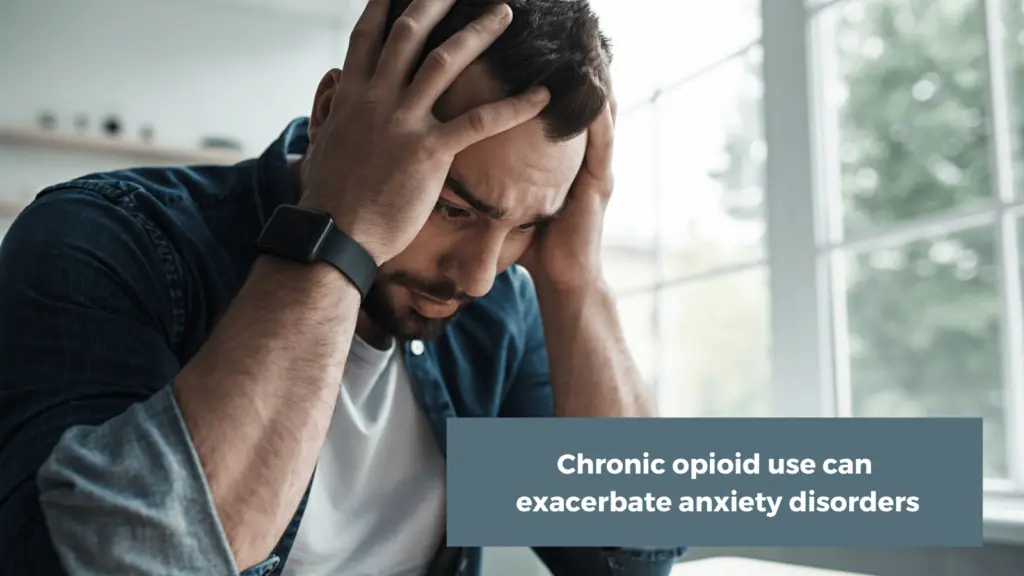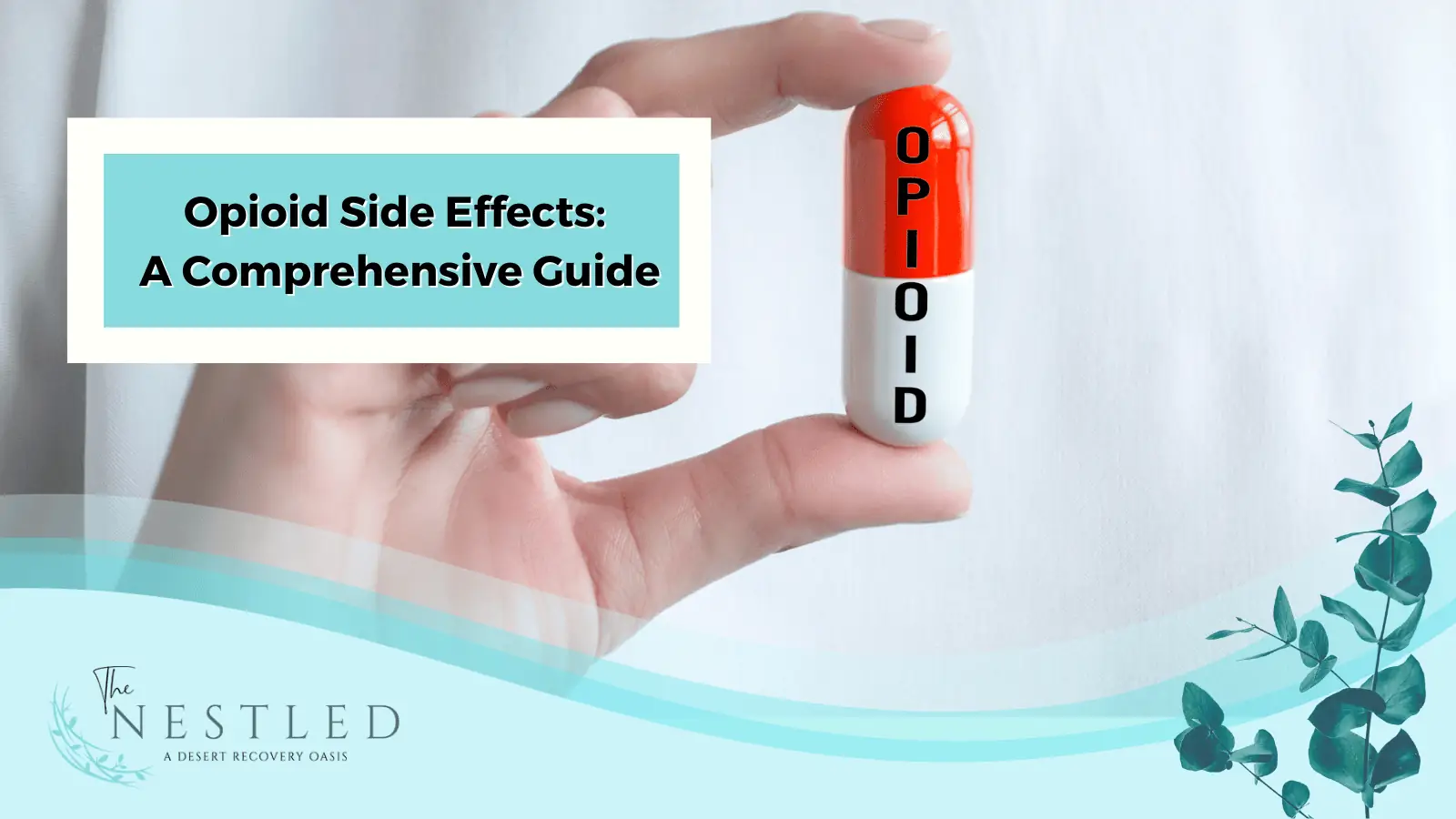Opioids, encompassing a broad range of prescription and illicit drugs, are potent pain relievers with a significant impact on public health due to their high potential for dependence and addiction. Originating either from the opium poppy or synthesized in labs, opioids include well-known medications like morphine, oxycodone, and the illegal drug heroin.
While effectively managing pain, their usage is often accompanied by a spectrum of opioid side effects, from drowsiness and constipation in mild cases to life-threatening respiratory depression in severe instances. Understanding these side effects is crucial for both healthcare professionals and patients to mitigate risks and ensure safe usage.

What Are Opioids?
Opioids are a class of drugs, typically prescribed by a doctor, for their pain-relieving properties. They work by binding to specific receptors in the brain and nervous system, effectively dulling the perception of pain. This class includes both naturally derived compounds, like morphine and codeine, sourced from the opium poppy, and synthetic drugs, such as oxycodone and fentanyl, which are created in laboratories.
While invaluable in managing moderate to severe pain, especially post-surgery or in chronic conditions, opioids also carry a risk of dependence and addiction due to their effect on the brain’s reward system, making their use a subject of careful consideration in medical practice.
Types of opioids:
- Morphine: Naturally derived from the opium poppy, used for severe pain.
- Codeine: Often used for mild to moderate pain relief and cough suppression.
- Oxycodone: A synthetic opioid, commonly prescribed for moderate to severe pain.
- Hydrocodone: Typically combined with acetaminophen, used for pain relief.
- Fentanyl: A synthetic opioid, much more potent than morphine, used for severe pain, often in a hospital setting.
- Methadone: Used in pain management and in treating opioid dependency.
- Heroin: An illegal opioid, known for its high potential for addiction and abuse.
- Buprenorphine: Used in treatment of opioid addiction and moderate acute pain.
- Tramadol: A lower potency opioid used for moderate pain.
- Meperidine (Demerol): An older synthetic opioid, used less frequently now due to side effects and risks.
Each of these opioids varies in potency, duration of action, and risk profile, and they are used for different therapeutic purposes.
Immediate Side Effects of Opioid Use: What to Expect
When taking opioids, users may experience a range of immediate side effects, which can vary in intensity based on the specific opioid, dosage, and individual response. Common immediate side effects include:
- Drowsiness: Opioids often induce a sense of sleepiness or lethargy.
- Constipation: A very common side effect, as opioids slow down the digestive system.
- Nausea and Vomiting: These can occur, especially in individuals new to opioid use or after a dose increase.
- Respiratory Depression: A serious side effect where breathing becomes slow and shallow, potentially life-threatening at high doses.
- Itching: Many users report itching or skin reactions.
- Dry Mouth: Opioids can reduce saliva production, leading to a feeling of dryness in the mouth.
- Miosis: Constriction of the pupils is a classic sign of opioid use.
- Euphoria: The feeling of intense joy or pleasure, which can contribute to the development of addiction.
- Confusion or Mental Fog: Some users may experience cognitive impairments or a feeling of being in a fog.
- Urinary Retention: Difficulty in urinating is a less common but potential side effect.
These side effects can impact the safety and well-being of the user, particularly in cases of misuse or overdose. It’s important for users and caregivers to be aware of these effects and to use opioids as directed by a healthcare professional.
Long-Term Effects of Opioids on the Body and Mind
The long-term use of opioids can lead to a range of persistent effects on both the body and mind, many of which can be quite serious. Common long-term side effects experienced by opioid users include:
- Physical Dependence: The body adapts to the presence of the drug, leading to withdrawal symptoms when use is reduced or stopped.
- Tolerance: Over time, users may require higher doses to achieve the same pain-relieving effects, increasing the risk of overdose.
- Chronic Constipation: Long-term opioid use often leads to ongoing issues with bowel movements.
- Respiratory Issues: Prolonged use can lead to chronic respiratory problems due to reduced breathing rate and depth.
- Cognitive Impairment: Long-term users may experience memory issues, reduced concentration, and clouded thinking.
- Mood Disorders: Users are at an increased risk of developing depression or anxiety disorders.
- Hormonal Imbalances: Opioids can disrupt the normal functioning of the endocrine system, affecting sex hormones and stress response.
- Weakened Immune System: There is evidence suggesting that chronic opioid use can impair the body’s immune response.
- Sleep Disturbances: Long-term use can disrupt normal sleep patterns, leading to insomnia or disrupted sleep.
- Increased Pain Sensitivity: Some users may experience heightened sensitivity to pain, a condition known as opioid-induced hyperalgesia.
These long-term effects underscore the need for careful management and monitoring of opioid use, particularly for chronic pain management, to minimize potential health risks and improve overall quality of life.

The Impact of Opioids on Mental Health
The use of opioids can significantly impact mental health, with both short-term and long-term consequences. Here are some key ways opioids affect mental health:
- Anxiety Disorders: Chronic opioid use can lead to or exacerbate anxiety disorders. The interplay between opioid use and anxiety can create a vicious cycle, where one condition perpetuates the other.
- Cognitive Impairment: Opioids can affect cognitive functions, leading to difficulties with concentration, memory, and decision-making. This can impact daily functioning and overall quality of life.
- Psychological Dependence: The euphoric effects of opioids can lead to psychological dependence, where users rely on the drug to cope with stress, emotional pain, or social situations.
- Social Isolation and Relationship Problems: Opioid addiction can lead to withdrawal from social activities and strained relationships, contributing to feelings of loneliness and isolation.
- Aggravation of Pre-existing Mental Health Conditions: For those with pre-existing mental health conditions, opioid use can worsen symptoms or hinder the effectiveness of mental health treatments.
- Increased Risk of Suicide: The combination of addiction, mental health issues, and social consequences can lead to an increased risk of suicidal thoughts and behaviors.
What should I do if I experience side effects from opioids?
If you experience side effects from opioids, it’s crucial to take immediate action. First, consult with your healthcare provider to assess the situation and adjust your treatment plan. For severe or life-threatening symptoms like difficulty breathing, severe drowsiness, or loss of consciousness, seek emergency medical attention immediately.
Additionally, keep a record of your symptoms and discuss them with your healthcare provider, as this can aid in determining the best course of action, whether it involves altering the dosage, switching medications, or exploring alternative pain management strategies. Remember, it’s important to manage opioid use under close medical supervision to ensure safe and effective treatment.
How Can I manage pain, when stopping the use of Opioids?
Managing pain during opioid withdrawal can be challenging, as the body adjusts to the absence of the drug it has become accustomed to. Here are some strategies and tips to effectively manage pain during this period:
- Consult with a Healthcare Professional: Before beginning the withdrawal process, it’s essential to consult with a healthcare provider. They can create a tailored plan to manage pain and withdrawal symptoms, possibly including a gradual tapering schedule to ease the process.
- Non-Opioid Pain Relievers: Over-the-counter pain medications like acetaminophen, ibuprofen, or naproxen can be used to manage pain, as long as they are taken according to the guidelines and under medical supervision.
- Prescription Non-Opioid Medications: In some cases, doctors may prescribe non-opioid pain medications, such as certain antidepressants or anticonvulsants, which can help with neuropathic pain.
- Physical Therapy and Exercise: Gentle exercises, stretching, and physical therapy can help reduce muscle pain and stiffness. Activities like yoga and tai chi can also be beneficial.
- Mind-Body Techniques: Practices such as meditation, deep breathing exercises, and mindfulness can help manage pain by reducing stress and improving coping strategies.
- Heat and Cold Therapy: Applying heat or cold to painful areas can provide relief. Heat can relax muscles and improve blood flow, while cold can reduce inflammation and numb more intense pain.
- Massage Therapy: Massage can help alleviate muscle tension and pain, promote relaxation, and improve circulation.
- Acupuncture: Some find acupuncture effective in managing pain and withdrawal symptoms. It involves inserting thin needles into specific points on the body to relieve pain.
- Cognitive Behavioral Therapy (CBT): CBT can be effective in managing chronic pain and the psychological aspects of withdrawal. It helps in developing coping strategies and changing negative thought patterns about pain.
- Support Groups and Counseling: Emotional and psychological support are crucial during withdrawal. Support groups, counseling, or therapy can provide emotional support and strategies for coping with pain and withdrawal symptoms.
- Hydration and Nutrition: Maintaining good hydration and a balanced diet can help the body heal and manage withdrawal symptoms more effectively.
- Rest and Sleep: Adequate rest is important for pain management and overall recovery. Creating a comfortable, relaxing sleep environment can help improve sleep quality during withdrawal.

How can The Nestled Help?
Understanding the complexities of opioid use, including their side effects and the availability of alternative pain management options, is crucial for making informed decisions about your health. While opioids can be effective for certain types of pain, their potential for addiction and other serious side effects necessitates a careful approach. Exploring and considering non-opioid pain relief methods can provide effective and safer options for managing pain.
If you or someone you know is struggling with opioid dependency or seeking alternative pain management strategies, The Nestled Recovery is here to help. With a comprehensive approach to treatment and a team of experienced professionals, we offer personalized care to address both physical and psychological aspects of pain and addiction. Contact The Nestled Recovery today to take the first step towards a healthier, pain-free life.








